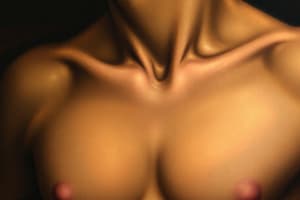Podcast
Questions and Answers
Which condition is characterized by high blood calcium and low bone calcium levels?
Which condition is characterized by high blood calcium and low bone calcium levels?
- Hyperparathyroidism (correct)
- Tetany
- Osteoporosis
- Hypoparathyroidism
What clinical feature is associated with hypoparathyroidism?
What clinical feature is associated with hypoparathyroidism?
- Increased serum calcium
- Bone and joint pain
- Gradual loosening of teeth
- Tetany and paraesthesias (correct)
Which radiographic feature is associated with hyperparathyroidism?
Which radiographic feature is associated with hyperparathyroidism?
- Delayed eruption of teeth
- Basal ganglia calcification
- Ground glass appearance of the jaws (correct)
- Increased lamina dura density
Which demographic is more likely to be affected by hyperparathyroidism?
Which demographic is more likely to be affected by hyperparathyroidism?
What is a common radiographic finding in patients with hypoparathyroidism?
What is a common radiographic finding in patients with hypoparathyroidism?
What is a characteristic feature of individuals with dwarfism related to thyroid conditions?
What is a characteristic feature of individuals with dwarfism related to thyroid conditions?
Which condition is characterized by excessive production of thyroxin in the thyroid gland?
Which condition is characterized by excessive production of thyroxin in the thyroid gland?
What is a common radiographic finding in children with hyperthyroidism?
What is a common radiographic finding in children with hyperthyroidism?
Which symptom is NOT associated with hypothyroidism in adults?
Which symptom is NOT associated with hypothyroidism in adults?
What condition is associated with delayed eruption and dental development in children?
What condition is associated with delayed eruption and dental development in children?
Which of the following symptoms is NOT characteristic of hyperthyroidism?
Which of the following symptoms is NOT characteristic of hyperthyroidism?
What is a key dental finding in an adult with hypothyroidism?
What is a key dental finding in an adult with hypothyroidism?
What condition results from insufficient secretion of thyroxin during childhood?
What condition results from insufficient secretion of thyroxin during childhood?
What is a potential result of hyperpituitarism in adults?
What is a potential result of hyperpituitarism in adults?
Which systemic disease is characterized by impaired growth of bones and soft tissues in children?
Which systemic disease is characterized by impaired growth of bones and soft tissues in children?
What radiographic feature is commonly associated with acromegaly?
What radiographic feature is commonly associated with acromegaly?
Which condition describes the underactive anterior pituitary gland leading to reduced hormone secretion?
Which condition describes the underactive anterior pituitary gland leading to reduced hormone secretion?
What is the primary impact of hyperparathyroidism on bone health?
What is the primary impact of hyperparathyroidism on bone health?
What is a primary characteristic of osteopetrosis?
What is a primary characteristic of osteopetrosis?
Which hormone's overproduction in the anterior pituitary gland can lead to gigantism?
Which hormone's overproduction in the anterior pituitary gland can lead to gigantism?
Which systemic condition can lead to the ballooning of the sella turcica radiographically?
Which systemic condition can lead to the ballooning of the sella turcica radiographically?
Flashcards are hidden until you start studying
Study Notes
Systemic Diseases Manifested in the Jaws
- Systemic diseases can affect the form and function of bones and teeth.
- Endocrine Disorders
- Affect the endocrine system, which is a system of ductless glands that regulate body functions through hormones secreted into the bloodstream.
- Hyperpituitarism
- Occurs when anterior lobe of pituitary gland overproduces growth hormone.
- Gigantism - excessive growth in children, with normal body proportions.
- Acromegaly - excessive bone and tissue growth in adults, mainly affecting the mandible, hands, and feet.
- Radiographic Features
- Enlargement of sella turcica.
- Enlarged paranasal sinuses, especially frontal sinus.
- Thickened outer table of skull.
- Enlarged jaws, especially mandible, with spacing of teeth and overgrowth of posterior alveolar bone.
- Enlarged, protruding tongue.
- Enlarged condyles and rami.
- Hypercementosis and supereruption of posterior teeth.
- Hypopituitarism
- Reduced secretion of pituitary hormones.
- Dwarfism - small but relatively well-proportioned bodies.
- Radiographic Features
- Normal primary teeth eruption with delayed exfoliation.
- Normal crowns of permanent teeth with delayed eruption.
- Absence of third molars.
- Small jaws with crowding and malocclusion.
- Hyperthyroidism (Thyrotoxicosis)
- Excessive thyroxin production in the thyroid gland.
- Radiographic Features
- Children - Advanced dental development and early eruption with premature loss of primary teeth.
- Adults - Decreased bone density.
- Hypothyroidism (Myxedema)
- Insufficient thyroxin secretion.
- Radiographic Features
- Myxedema (in adults)
- Periodontal disease.
- Tooth loss.
- Teeth separation due to enlarged tongue.
- Cretinism (in children)
- Delayed fontanelles closure and incorporation of wormanian bones in sutures.
- Delayed ossification of the skull base.
- Thin lamina dura.
- Short teeth.
- Myxedema (in adults)
- Hyperparathyroidism
- Excess parathyroid hormone (PTH) in circulation.
- Increased bone remodeling with osteoclastic resorption, mobilizing calcium from bones into the bloodstream.
- Radiographic Features
- Decreased jaw density.
- Trabecular pattern replaced by ground glass appearance.
- Demineralization and thinning of cortical boundaries.
- Partial or complete lamina dura loss.
- Radiopaque teeth against a background of decreased bone density.
- Brown nodes of HPT appear as multiple radiolucent lesions in the jaws.
- Hypoparathyroidism
- Insufficient PTH secretion causing hypocalcemia.
- Radiographic Features
- Basal ganglia calcification (in panoramic views)
- Enamel hypoplasia, external root resorption, delayed eruption, root dilaceration.
- Metabolic Bone Diseases
- Osteoporosis
- Decreased bone mass and density.
- Radiographic Features
- Thinning of cortical bone.
- Decreased trabecular bone density.
- Loss of lamina dura.
- Rickets and Osteomalacia
- Deficiency in vitamin D or calcium leading to impaired bone mineralization.
- Radiographic Features
- Rickets (in children) - Widening of epiphyseal plates, bowing of long bones, and delayed tooth eruption.
- Osteomalacia (in adults) - Thinning of cortical bone, widened trabeculae, and pseudo fractures.
- Hypophosphatasia
- Deficiency in alkaline phosphatase, leading to impaired bone mineralization.
- Radiographic Features
- Defective cementum formation around the roots.
- Enlarged pulp chambers.
- Radiolucent periapical lesions with poorly defined borders.
- Hypophosphatemia
- Low serum phosphate levels, affecting bone mineralization.
- Radiographic Features
- Thinning of cortical bone.
- Loss of lamina dura.
- Defective tooth formation.
- Renal Osteodystrophy
- Bone abnormalities associated with chronic kidney disease.
- Radiographic Features
- Osteosclerosis.
- Osteomalacia.
- Fibrous dysplasia.
- Osteopetrosis
- Rare bone disorder characterized by increased bone density and fragility.
- Radiographic Features
- Increased bone density.
- Obliterated marrow spaces.
- Delayed tooth eruption.
- Impacted teeth.
- Osteoporosis
- Other Systemic Diseases
- Progressive Systemic Sclerosis (Scleroderma)
- Connective tissue disorder affecting the skin, blood vessels, and internal organs, including the jaw.
- Radiographic Features
- Thickening of the periodontal ligament space around teeth.
- Resorption of alveolar bone.
- Abnormal tooth movement.
- Sickle Cell Anemia
- Inherited blood disorder affecting red blood cells.
- Radiographic Features
- "Hair on end" appearance of skull.
- Osteolytic lesions in bone.
- Osteomyelitis.
- Delayed tooth eruption.
- Pulpal obliteration.
- Thalassemia
- Inherited blood disorder causing insufficient hemoglobin.
- Radiographic Features
- "Hair on end" appearance of skull.
- Bone marrow expansion.
- Osteolytic lesions in bone.
- Maxillary sinus opacification.
- Delayed tooth eruption.
- Tooth enamel hypoplasia.
- Progressive Systemic Sclerosis (Scleroderma)
Studying That Suits You
Use AI to generate personalized quizzes and flashcards to suit your learning preferences.




